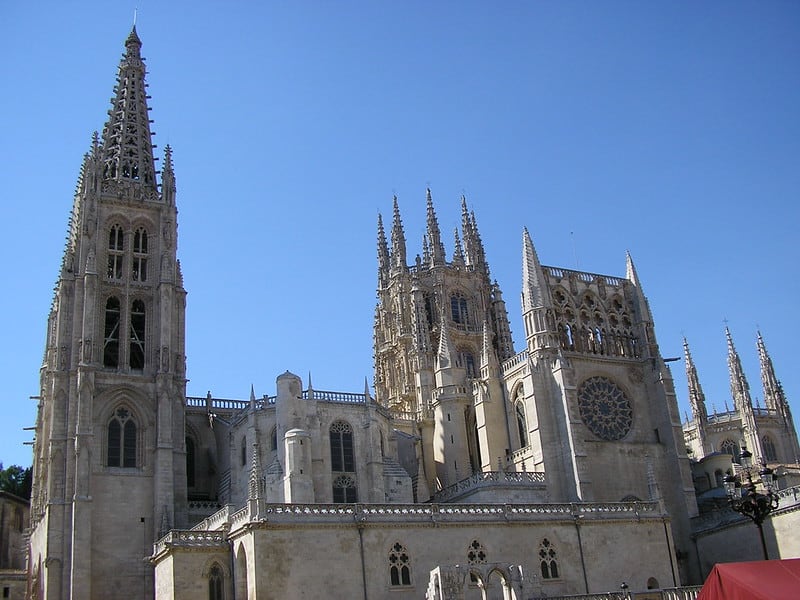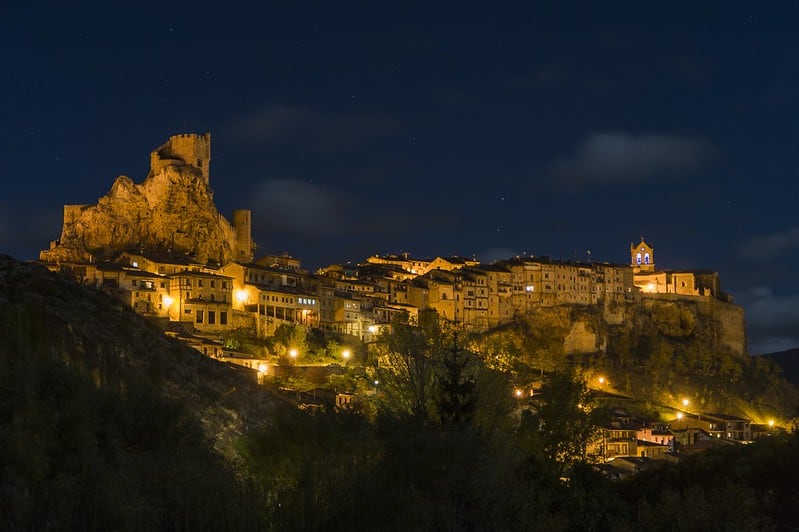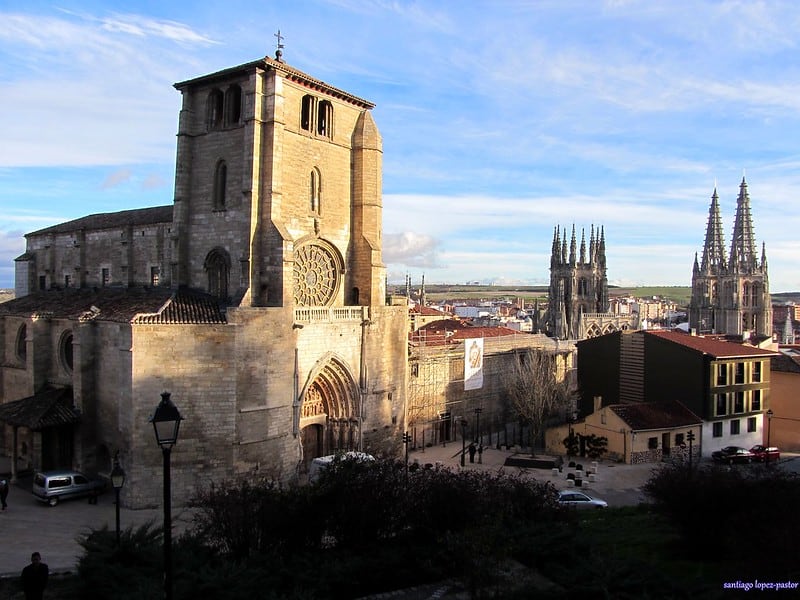Burgos’ 13th-century cathedral is a UNESCO World Heritage Site. It took 40 years to complete and displays both Romanesque and French Gothic architecture. Admire the intricate wooden ceilings or explore the Capilla de Santa Maria, home to the gilded high altar that commemorates the first shipments of gold from the Americas.
The History of Burgos Spain
Nestled in the Castile and León region of Spain, Burgos is a city steeped in history, boasting a rich tapestry of events, cultures, and architectural wonders. From its ancient origins as a Roman settlement to its role in shaping Spanish history, Burgos stands as a living testament to the past. In this article, we’ll take you on a chronological journey through the history of Burgos, exploring its milestones and significance in the broader context of Spain’s narrative.
Ancient and Medieval Foundations
- 1st Century BC: The history of Burgos dates back to the Roman era when it was known as “Clunia.” As a Roman settlement, it played a strategic role in communication routes and trade networks.
- 9th Century: The city’s history during the Moorish rule is marked by its recapture by King Alfonso III of Asturias, marking a turning point in its transformation from a Muslim stronghold to a Christian bastion.
- 11th Century: Burgos gained prominence during the reign of King Ferdinand I of Castile. The construction of Burgos Cathedral began during this period, eventually becoming one of the city’s most iconic landmarks.
Royal Capital and Cultural Center
- 13th Century: Burgos solidified its status as a royal capital under the reign of Alfonso VIII. The city’s growing importance led to the convening of the Kingdom of Castile’s Parliament in the city.
- 15th Century: Burgos played a crucial role in the Catholic Monarchs’ campaign to unite Spain. It was here that Isabella I of Castile and Ferdinand II of Aragon married, uniting their realms and setting the stage for the creation of modern Spain.
Cultural Flourish and Historical Significance
- 16th Century: The Renaissance era brought cultural and artistic growth to Burgos, with the construction of impressive palaces and churches.
- 19th Century: The Peninsular War and subsequent civil disturbances had an impact on Burgos, leading to a decline in its economic and political influence.
Modern Revival and Heritage Preservation
- 20th Century: Efforts to preserve and restore Burgos’s historical heritage gained momentum. The city’s old town, with its narrow streets and medieval architecture, was declared a UNESCO World Heritage Site in 1984.
- 21st Century: Burgos continues to be a hub of historical preservation, with ongoing efforts to showcase its rich history and cultural significance.
Catedral De Burgos
The Cathedral of Burgos is the best-known landmark in the city and a must-see. You can spend a day exploring the cathedral and the great cloister, as well as its museum’s Flemish tapestries. To get the most out of your visit, prepare by searching for hours with fewer visitor traffic and entering with clothes appropriate for a religious temple. Also, bring binoculars to help you observe the intricate carvings on its ceilings and towers.

The magnificent Gothic church was added to the UNESCO World Heritage Site in 1984. The cathedral took over 40 years to complete and offers a stunning mix of Romanesque, Renaissance and French Gothic architecture. Inside, feast your eyes on the stunning high altar that was gilded with one of the first gold shipments from the Americas and the tomb of medieval military leader and Burgos hero El Cid.
Outside the cathedral, you can find a number of interesting sites, including the Arco de Santa Maria, one of the 12 medieval doors to the city. It is carved with figures and offers stunning views of the city.

Cartuja de Miraflores
A trio of 15th-century masterpieces by Gil de Siloe—the man behind Burgos cathedral’s gorgeous features—are on display in this monastery set among serene woodlands. It would be even more impressive if Napoleon’s French army hadn’t destroyed much of it during the Peninsular War.
The main square in Burgos was once the city’s bustling center of commerce, where local farmers and traveling merchants sold food, textiles, and other goods. Today, Plaza Mayor is more of a hub for socializing than shopping, with benches and trees inviting visitors to relax or enjoy the many bars and restaurants that line the square.
At one end of the plaza is a twin column of pollarded plane trees, while at the other is a charming antique carousel and iron gas lamps from the 19th century. You’ll also see sculptures and the Arco de Santa Maria, one of 12 original mediaeval gates to the city. During the day, head here to browse historic shops like Libreria del Espolon, and in the evening to catch a glimpse of locals enjoying dinner and drinks along the tree-lined promenade.
Arco de Santa Maria
One of the most epic entrances into Burgos, this structure takes visitors by surprise with its Romanesque and Gothic architecture. It took 40 years to complete and is now a Unesco World Heritage Site. It also features a 13th-century crucifix and the tomb of the medieval hero El Cid.
Atop the city’s iconic Arch of Santa Maria, you can enjoy a gorgeous view of Burgos. Observe the stunning cityscape from here and spot all of its famous landmarks, including the Cathedral and the Mirador Castillo. There are detailed bronze etchings on the railings, which make it easy to identify each building.
If you want to take a break from the crowded cities and relax in nature, this place is for you. Here, you can sit in the grass and listen to the chirping of birds and the sound of ducks swimming around. You can even spend the afternoon here meditating and relaxing.
Capilla de Los Condestables
This beautiful building is a must-see for any Burgos traveler. The octagonal Chapel of the Condestables is an example of flamboyant Gothic style, featuring gold details, angels, and heraldry. Inside, visitors will find several impressive historical artifacts.
Another attraction of the city is the imposing statue of El Cid, a medieval hero of Spain. Located in the Plaza del Cid, this is one of the most popular sights of the city and is especially impressive before the start of the Fiestas de Burgos.
The ancient wall of Burgos is also a must-see for visitors. The walls stretch over a large area of the city and offer stunning views from the top. The best time to visit the wall is around sunset, when the light can be spectacular.
Parque de la Isla
As with all medieval cities, Burgos was ringed by walls, and one of the original entrance gates still stands. The Arco de Santa Mara is a castle-like gate from the 15th century, with six alcoves for statues of notable citizens.
Walking the Paseo del Espolón is a pleasant way to take in Burgos’ historic attractions while enjoying the shade of its trees. This riverside promenade is lined with sculptures, a twin column of pollarded plane trees, and iron gas lamps from the 19th century. The path also leads to the city’s cathedral, and the ruins of the castle that would have been a spectacular sight if not for Napoleon’s army when they left Burgos in 1813.
This stunning UNESCO World Heritage Site took 40 years to complete, and is worth the admission price for its amazing architecture alone. The cathedral’s highlights include a 13th-century crucifix and the Capilla de Santa Tecla, which features a beautiful ceiling. It also holds the mortal remains of El Cid, a military leader from medieval times that is a hero to this region.
Monasterio de las Huelgas
The Monasterio de las Huelgas is one of Burgos’ most hidden treasures. This monastery was once home to the affluent merchant family of the same name and features elaborate Gothic retablo carvings, as well as a chapel with a starred vault. The monastery is a must-see for any history buff.
Another must-see is the Plaza Mayor, which is a large central square in the heart of the city. This bright, vibrant square is a hub of activity from day to night, with events being held and people chatting over a glass of wine. It is especially jovial when the sun goes down, making it the perfect place to soak up the atmosphere of the city.
You’ll also find the beautiful church of San Lesmes Abad, which is dedicated to Saint Leonard and contains the mortal remains of the patron saint of Burgos, El Cid. This impressive church was added to the UNESCO World Heritage list in 1984. You can visit the church for a small fee and admire its stunning interiors.
Museo de Burgos
The Burgos Museum of Books is an absolute must for bibliophiles. Its exhibition themes range from antiquity through manuscripts and codices to the Renaissance and the birth of printing. It also includes facsimiles of some of the most seminal books of all time.
Another highlight is the Church of San Nicolas, a gothic structure built between 1484 and 1516 with an amazing limestone altarpiece. Its a simple facade masks a remarkably rich interior, and the retablo is so intricate that you’ll need to take a good ten minutes to admire its carvings.
A good place to end your day is the Plaza Mayor, where you can sit at sunset and watch the city life unfold. The square is especially lively in the evenings when events are being held and locals gather to chat. The area is right next door to Ribera de Duero, home of Tempranillo, one of Spain’s most iconic red wines, and you’ll find plenty of wine shops and bars on Calle Paloma and Calle de lain Calvo.
Museo de la Evolucion Humana
With its soaring cathedral and castle overlooking the city, Burgos is a must-see destination on Spain’s El Camino pilgrimage route. The city also has a wealth of historic landmarks that celebrate its role in medieval warfare and the birthplace of El Cid, an 11th-century hero of the Spanish conquest of Muslim kingdoms.
The stunning, Gothic-style cathedral’s elaborate high altar is a highlight of its interior. A large section of the nave is carved with figures, and there are a number of medieval paintings on display. The adjacent chapel contains the graves of several important Catholic families, including those of the affluent Polanco family, which funded much of the church’s lavish decoration.
The cathedral’s main square, Plaza Mayor, was once a bustling market where local farmers and traveling merchants sold food and textiles. Today, it’s a place for locals to gather and relax in its serene surroundings. Another top attraction is the Paseo del Espolon, a riverside trail lined with trees. It’s a great place to take a hot summer stroll while being shaded by the lush foliage.
Best Places to Stay in Burgos Spain
Whether you’re a history enthusiast, a food lover, or simply seeking a relaxing getaway, Burgos offers a range of accommodation options that promise both comfort and proximity to the city’s iconic attractions. In this article, we’ll explore some of the best places to stay in Burgos, ensuring a memorable and delightful visit.
1. Parador de Burgos: A Historic Haven**
Steeped in history, the Parador de Burgos offers an unforgettable stay within the walls of the legendary Burgos Cathedral. This luxurious hotel boasts elegantly furnished rooms that blend modern amenities with medieval ambiance. Enjoy stunning views of the cathedral and the city as you indulge in exceptional dining and personalized service.
2. Hotel Rice Palacio de los Blasones: Classic Elegance**
This charming hotel combines classic elegance with modern comforts. Located in the heart of the historic center, Hotel Rice Palacio de los Blasones offers spacious rooms adorned with antique furniture. Its central location ensures easy access to the city’s attractions, making it an ideal choice for travelers seeking convenience and sophistication.
3. Hotel Landa: Tranquil Retreat**
Situated on the outskirts of Burgos, Hotel Landa offers a peaceful retreat surrounded by lush gardens and picturesque countryside. The hotel’s comfortable rooms and well-manicured grounds provide a serene atmosphere, perfect for unwinding after a day of exploring the city. The on-site restaurant offers delectable local cuisine, enhancing your overall experience.
4. NH Collection Palacio de Burgos: Modern Luxury**
For travelers who appreciate modern design and luxurious amenities, the NH Collection Palacio de Burgos delivers. Located in a former 16th-century palace, this hotel seamlessly blends historic architecture with contemporary style. The rooftop terrace offers panoramic views of the city, and the hotel’s central location ensures easy access to Burgos’ main attractions.
5. AC Hotel Burgos: Sleek Comfort**
With its sleek and minimalist design, the AC Hotel Burgos offers a comfortable and stylish stay. The hotel’s central location makes it a convenient base for exploring the city’s historical sites, museums, and restaurants. Enjoy the modern amenities, including a fitness center and a terrace bar with panoramic views.
6. Hotel Norte y Londres: Charming Boutique Stay**
For a cozy and charming experience, consider the Hotel Norte y Londres. This boutique hotel is located in the heart of Burgos, offering easy access to landmarks like the Burgos Cathedral and the Plaza Mayor. The hotel’s warm and welcoming ambiance, along with its personalized service, creates an intimate retreat for travelers.
7. Hotel Mesón del Cid: Historic Comfort**
Situated just steps away from Burgos Cathedral, the Hotel Mesón del Cid immerses guests in the city’s history. The traditional Castilian-style architecture and décor transport you to another era. With its central location and proximity to the city’s main attractions, this hotel offers a perfect blend of comfort and cultural immersion.
Best Places to Eat in Burgos Spain
Burgos, located in the enchanting region of Castile and León, Spain, offers a culinary journey that’s deeply rooted in its rich history and cultural heritage. From traditional Castilian dishes to modern gastronomic delights, the city boasts a diverse array of dining experiences that cater to every palate. In this article, we’ll embark on a flavorful exploration of the best places to eat in Burgos, where local ingredients and culinary artistry come together to create an unforgettable dining experience.
1. Mesón del Cid: A Timeless Gastronomic Experience**
Nestled within a historic setting near Burgos Cathedral, Mesón del Cid offers a dining experience steeped in tradition. The restaurant’s medieval-inspired decor and ambiance perfectly complement its menu of hearty Castilian cuisine. Indulge in classics like roasted lamb and suckling pig, expertly prepared to capture the essence of the region’s culinary heritage.
2. Landa: A Michelin-Starred Delight**
For those seeking a gourmet experience, Landa is a Michelin-starred restaurant that brings innovation to traditional flavors. Led by Chef Jesús Laya, the restaurant offers an ever-evolving menu that highlights local ingredients in creative and unexpected ways. The elegant setting and attentive service enhance the dining experience, making it a true culinary gem.
3. Casa Ojeda: Gastronomic Nostalgia**
Casa Ojeda captures the essence of Burgos’ culinary traditions with a focus on homemade and locally sourced ingredients. This family-run restaurant offers a menu filled with classic dishes, from Castilian soup to grilled meats. The warm and inviting atmosphere adds to the feeling of dining in a traditional Castilian home.
4. El Morito: Tapas and Local Flavors**
For a taste of Burgos’ vibrant tapas scene, El Morito is a must-visit. This bustling tapas bar offers a variety of small plates featuring local ingredients and flavors. From chorizo-stuffed mushrooms to jamón ibérico, each bite is a delightful explosion of taste. Pair your tapas with a glass of local wine or a refreshing cerveza for the full experience.
5. Restaurante Horno de la Merced: Rustic Elegance**
Set within a restored 14th-century convent, Restaurante Horno de la Merced combines rustic charm with culinary excellence. The restaurant specializes in Castilian cuisine with a modern twist, offering dishes that are both visually stunning and delectably flavorful. The historic setting and attentive service make it a memorable dining destination.
6. Asador Casa Pancho: Grilled Delicacies**
Known for its mastery of grilling techniques, Asador Casa Pancho serves up succulent roasted meats and grilled specialties. The menu showcases a variety of cuts cooked to perfection, making it a haven for meat lovers. The cozy and traditional ambiance adds to the overall experience, inviting guests to savor every bite.
Conclusion
Burgos’ culinary scene is a celebration of its rich history and local flavors. From traditional eateries that pay homage to age-old recipes to modern gastronomic establishments pushing the boundaries of innovation, the city offers an array of dining experiences that cater to diverse tastes. As you explore these best places to eat in Burgos, you’ll not only satisfy your palate but also immerse yourself in the cultural and culinary wonders that define this captivating Spanish city.
10 interesting facts about Burgos Spain
- Historic Cathedral: The Burgos Cathedral, also known as the Cathedral of Saint Mary of Burgos, is a UNESCO World Heritage Site and one of Spain’s most impressive Gothic cathedrals. Its construction began in 1221 and continued over several centuries, resulting in a masterpiece of architecture.
- El Cid Connection: Burgos is closely associated with the legendary Spanish hero, El Cid. Rodrigo Díaz de Vivar, commonly known as El Cid, was a medieval nobleman and military leader who played a significant role in the Reconquista against the Moors. His tomb is located in the Burgos Cathedral.
- Burgos Charterhouse: The Monastery of Santa María la Real de Las Huelgas, known as Burgos Charterhouse, is a Cistercian monastery founded in 1187. It has an extensive history and is notable for its impressive architecture, including a Gothic church and royal tombs.
- Archaeological Discoveries: Burgos has a rich archaeological heritage. The Atapuerca Mountains near the city are home to the Atapuerca archaeological site, where important prehistoric fossils have been discovered, shedding light on early human history in Europe.
- Historic Old Town: The medieval old town of Burgos is a treasure trove of history and architecture. Its well-preserved streets, squares, and buildings reflect the city’s long history, making it a charming place to explore on foot.
- Burgos Evolution Festival: The city hosts the Burgos Evolution Festival, an annual event that celebrates urban culture through music, art, sports, and more. It draws participants and visitors from around the world, creating a dynamic and vibrant atmosphere.
- Papamoscas Clock: The Papamoscas Clock, located on the facade of the Burgos Cathedral, is a unique astronomical clock that features a figure that opens its mouth to chime the hours and “eat” a bell. It’s a popular attraction for visitors.
- Gastronomy: Burgos is renowned for its traditional Castilian cuisine. Dishes like morcilla de Burgos (blood sausage), lechazo asado (roast lamb), and queso de Burgos (fresh cheese) are integral to the local culinary culture.
- University of Burgos: The city is home to the University of Burgos, which offers a range of academic programs and contributes to the vibrant student life and cultural scene in the city.
- Viking Connection: Burgos has an unexpected Viking connection. A runestone, known as the “Rune Stone of Burgos,” was found in the city, suggesting that Vikings might have traveled to the area during the medieval period.

